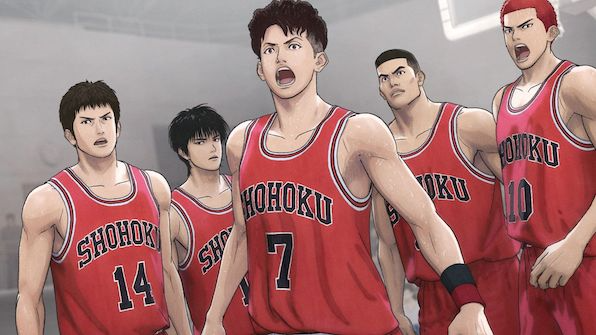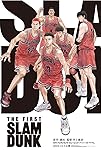Eye For Film >> Movies >> The First Slam Dunk (2022) Film Review
The First Slam Dunk
Reviewed by: Andrew Robertson

An animated high-school sports movie, The First Slam Dunk is also an adaptation of a long-running and beloved manga franchise. Running in Weekly Shonen Jump, an anthology comic whose closest UK analogue is probably still 2000AD, the collected work was printed in 31 volumes. Several titles have made the crossover from those pages, just as Dredd did. Slam Dunk is kin to works like Fist Of The North Star, Kimagure Orange Road, One Piece, Death Note, and Dragon Ball. There's good odds that if you've heard of all of those you'll know Slam Dunk, and if you've only heard of one you won't.
The film is focused on Ryota Miyagi. Seen in a subtitled version, the distinctions between the -kun, -chan, and other suffixes are left as an exercise to the tutored ear. Other translation issues come from the basketball focus. 'regular member' might be the term of art for 'starter' or similar. 'Goal' should perhaps be 'basket' or 'shot'. 'Cut' might be closer to 'interception', and so on. Those not familiar with those terms might be left struggling. While the film does much to introduce its multiple characters it seems to assume a level of familiarity with hoop sports that, as with a regulation basket, many will struggle to reach.
The First Slam Dunk might be more properly rendered with other punctuation. Though it's the first Slam Dunk film, there was an animated series. This builds massively on the style of that, leveraging digital imaging and animation techniques to create compelling action sequences. An introductory sequence that starts with character sketches that are gradually fleshed out before the transition to colour is striking. Later scenes use animation's ability to drop in and out of detail to good effect, using techniques that borrow from the same places as Spider-Man: Across The Spider-Verse. There's the same freewheeling camera too, bouncing from perspective to pivot to new points of view with speed and clarity.
Aided by significant foley work for the squeak of branded shoes on polished wooden court and bounce on board, the basketball sequences grab the eye as firmly as the players grasp the ball. Sometimes we get internal monologue that outlines tactics or motivation, but for the most part the mechanics of the sport, the threes, the twos, the shot clock, the forms of fouls, are unexplained. Would adding them have detracted from the flow? Possibly so, and it must be said that it's unlikely that anyone not interested in basketball would pick this up. It might be telling a human story, one of grieving and growth, but it does so through the glass backboard. Neither Hoop Dreams nor White Men Can't Jump were about basketball. Most sports films use it as a lens.
Takehiko Inoue writes, directs, adapts his own manga. It's a significantly more polished transition than Frank Miller's foray in The Spirit. It feels almost redundant to describe the court action as kinetic, but even when changing rate and focus Inoue's ability translates well. Some moments are slowed, some sped, with more control than an artist has over when a page is turned.
That control does have some downsides. At two hours and four minutes it's longer than a lot of animation, entering into territory that some streaming services would call a miniseries. Though it has a prologue, a post-credits epilogue, almost all its action takes place in a single basketball game. In the Japanese high-school competition depicted, that's two 20 minute halves. There's a lot more to the game than that.
The philosopher Zeno is usually associated with a set of paradoxes that includes a race between Achilles and a tortoise. Achilles, the runner, gives the tortoise a head start. He catches up half way, and then half way again, and then half way again. The First Slam Dunk similarly divides its time. The second half starts about 20 minutes into the film but the next quarter takes about as long, then the next eighth, then the next sixteenth. Filling that time is flashback, sometimes nested. The other players are introduced, their backstories fleshed out. A good indicator as to how expansive a series is involves the number of characters with their own Wikipedia page. Everyone in red that's not on the bench has a blue link, and they're not alone.
The film does a good job of explaining rivalries, but some of those arcs are condensed such that their revelatory moments are met between the same lines of paint. That's as much a form of storytelling as an alley-oop, the intersection of motion to dramatic outcome. While we focus on Ryota, each of this team-mates is on a journey of their own, as are his rivals. I can't speak to the quality of the voice-acting in the dub, but the subtitled version doesn't have any sticking points. That extends to when it stretches the boundaries of realism into more expressionistically anime techniques, though it never goes to the extremes of the Mie poses of Kabuki.
There's some gorgeous technique at play here, including that motion-captured to inform the movement of the players. Painted backgrounds, art-styles that reflect different player's worldviews, even rain that is almost palpable. The state of the art for animation and its calibre can be seen in other contemporary titles like The Tunnel To Summer, The Exit Of Goodbyes.
Though the pacing is difficult it does pay off in suspense. The ever shorter stretches of game help raise the stakes again and again. After all, there's no victory until the end. That said, given the consistency of The First Slam Dunk's quality, audiences will be winning throughout.
The First Slam Dunk opened Japan Cuts 2023 in New York.
Reviewed on: 01 Aug 2023


















